Online exhibits : Field notes : Randy Irmis
Investigating the rise of dinosaurs: Field notes from Randy Irmis
By UCMP grad student Randy Irmis, mid-June, 2007
We've had a very successful field season thus far, with over 650 specimens excavated. Highlights include a large amount of phytosaur material, including a beautiful skull. Overall, the weather has cooperated; the frequent rain we had the first week has disappeared. We did have one day of 50 mph wind gusts, but thankfully that was an anomaly. The downside of no rain is that biting insects are out with a vengeance, particularly gnats. If you stop moving, they swarm you!
Virgil Trujillo, the Ranchlands Manager has again been super helpful with overburden removal. After some initial problems with starting the engine, Virgil brought in Ghost Ranch's 1960's vintage Caterpillar bulldozer to remove more overburden at one of our sites. In one day, he removed an amount of rock that would take at least a month to do by hand! This is especially helpful because it means that we will not have to do much overburden removal at this site for several years.
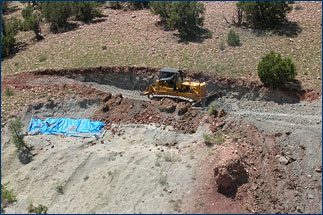 |
 |
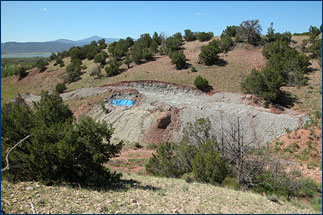 |

Left: Virgil Trujillo hard at work removing overburden with the Ghost Ranch bulldozer. The blue tarp marks the actual bone level. Right: The fruits of Virgil's labor. He removed hundreds of cubic feet of sediment, something that would take ages by hand. |
Screenwashing
 |
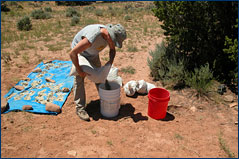
The first two steps of screenwashing as demonstrated by Nate Smith from the Field Museum in Chicago: (1) The sediment containing microfossils is poured into a bucket for soaking. (2) After several hours of soaking, the sediment is spread out on a tarp to dry, as in the photo. |
Last time I mentioned that we have a different technique for finding really small vertebrate fossils. When we quarry, we are careful to investigate the smallest of bones, but this is impractical when dealing with more microscopic remains. It would take way too long to break up each rock fragment and inspect it for fossils. Instead, we employ a technique called screenwashing. The first step is to bag a large amount of bulk sediment that will be screened. Typically this is at least 100 lbs of matrix, and sometimes ten or twenty times that amount. The matrix is then put in buckets to be soaked with water for several hours. After soaking, the sediment is spread out to completely dry. This wet/dry method is crucial — it causes the clays to expand and contract, ultimately allowing them to break up into small soft fragments that will crumble easily during screenwashing and reveal the fossils contained within. The next step is to fill mesh bags with sediment. These bags are put in the nearby creek, and weighed down with rocks. This method allows the creek to do most of the
work. The current will wash the mud out of the bags, leaving sand and fossils behind (particles that are too large to fit through the mesh). We periodically massage the bags to encourage the mud to leave, and give the bags a final wash before removing them from the flowing water. The resulting sand and fossils is called "screenwash concentrate." We spread it out on a white bedsheet to dry. Back in the lab, this concentrate will be examined under a microscope, and the fossils will be removed. However, it is already apparent that this matrix contains quite a few fossils (see the last photo at the bottom of this page).
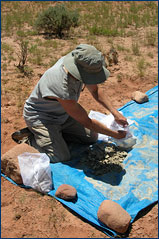 |
 |
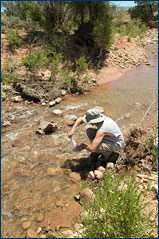 |
 |
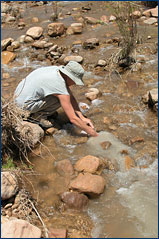 |
 |
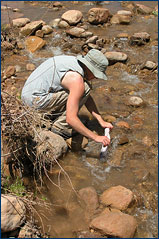 |

Screenwashing continues, from left: (3) Nate fills mesh bags with dried sediment, then (4) places the filled bags in the nearby creek and weighs down the open ends with large rocks so that the bags and sediment don't escape. The stream current will remove the mud from the sediment while leaving the sand and fossils. (5) Gently massaging the bags midway through the process helps release the mud. (6) Nate gives the bags a final rinse to remove any stubborn mud before taking the bags, with their remaining contents, out of the creek. |
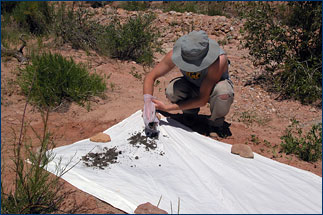 |
 |
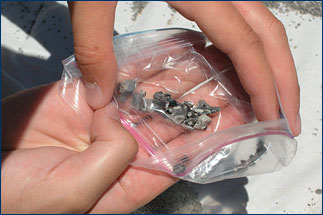 |

(7) The remaining sand and fossils are spread across a white bedsheet to dry. We will then pick through the sediment under a microscope in the lab. At right, plenty of fossils are already apparent after the sediment dries. Note
the toe claw on the right side of the bag. |
Next time I'll talk about how we remove larger fossils from the quarry once they're exposed.








